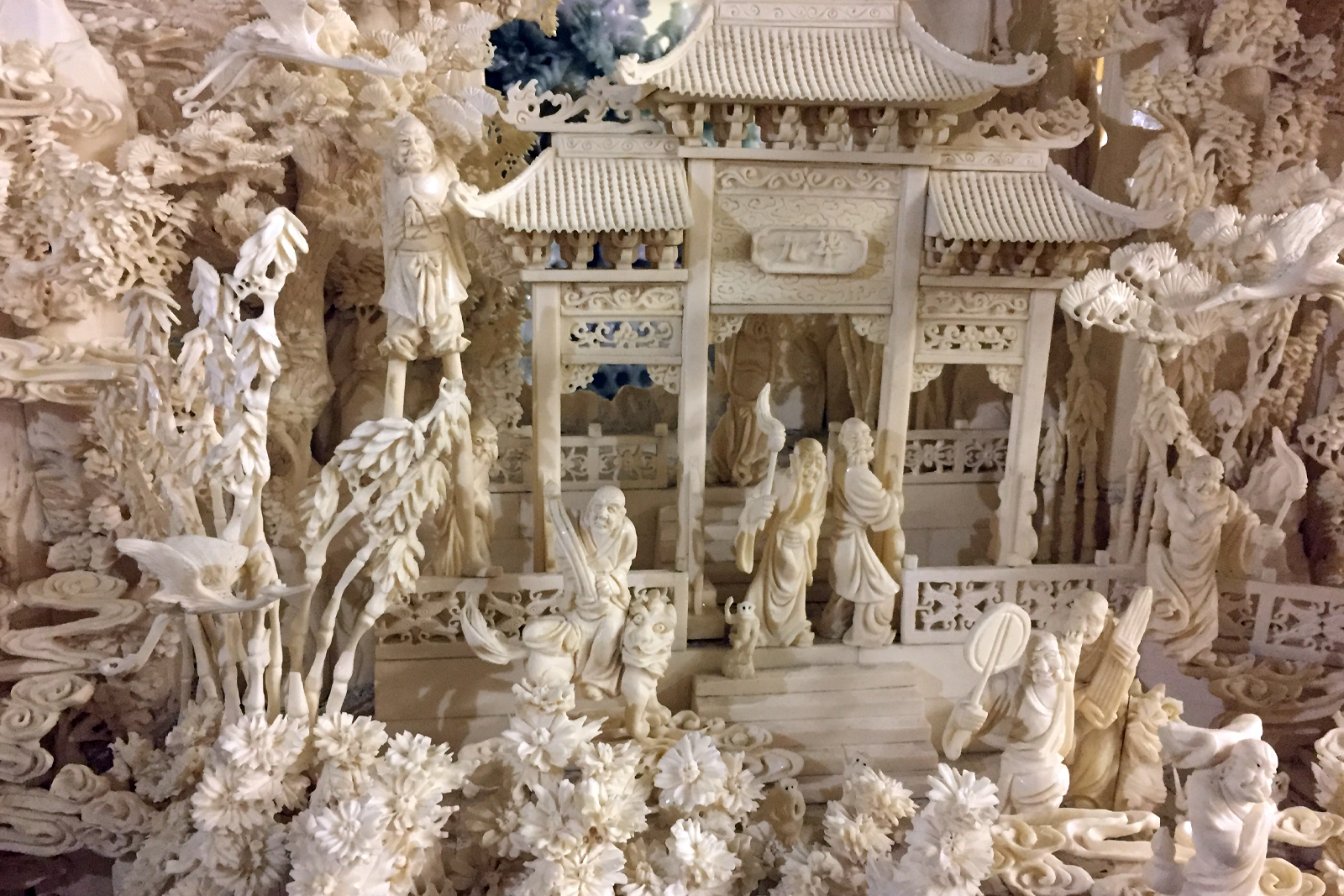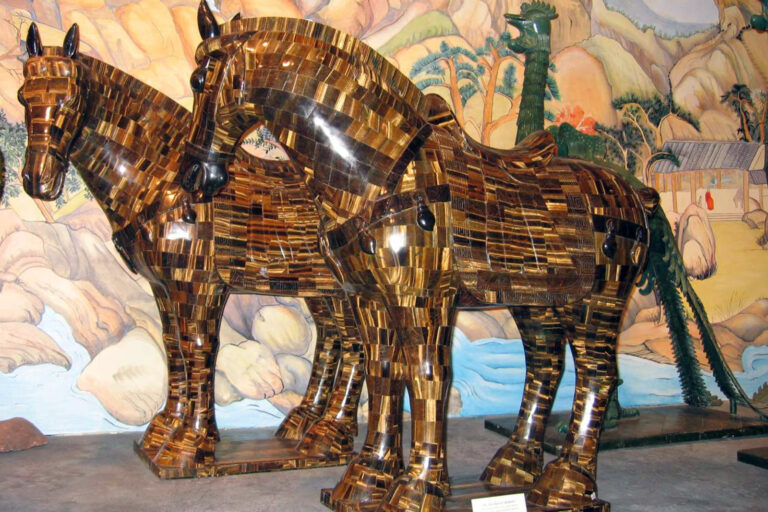The Belz Museum of Asian and Judaic Art in Memphis
This unique museum holds one of the largest collections of jade in the country. by Marilyn Sadler Memphis Magazine
When visitors ask Belinda Fish how long it will take to tour the museum that Fish oversees, she tells them, “It can take 45 minutes to an hour, or it can take all day.” Truly, the sight of so many magnificent pieces may compel tourists to linger longer than they planned. Not only are they awed by the beauty and intricacy of the art but by the fact that a gallery of this type is tucked away in downtown Memphis.
Located at 119 South Main, on the downstairs level of the Pembroke Square building, the Belz Museum of Asian and Judaic Art opened in 1998 as Peabody Place Museum and Gallery and held some 200 pieces of Chinese art. A decade later the Judaic section was added, the name was changed, and today, the museum features 1,400 works continually on display.
And such pieces they are — from a dinosaur egg dated at 100 million years old to works of exquisitely carved jade, including a five-section pagoda with a fluted top, to contemporary bronze panels that illustrate events from the Bible.
The Asian art collection started in the 1960s when Jack Belz — chairman and CEO of Belz Enterprises and creator of Peabody Place development — and his wife Marilyn made their first purchase from a collector’s gallery in Los Angeles. Today the Belzes lay claim to the largest private collection of Asian art in the U.S. While the museum pieces include ivory, coral, rose quartz, tiger eye, cloisonne, cinnabar, Mongolian silver, and more, jade comprises one third of the collection.
“We’re unofficially called the jade museum,” says Fish, who has been the museum’s director and education coordinator since 2010. Most of the jade comes from China’s Qing (or Ch’ing) dynasty that ran from 1644 until 1911, whose rulers were known for their love of beauty rather than conquest; many pieces were commissioned by royalty and graced palaces, temples, and institutional buildings. “In the early 1900s,” says Fish, “the emperor was forced out of power. After the revolution, a lot of the art left China or was destroyed. Considering all that was lost, we are fortunate to have this wonderful collection.”
Asked about other museums with a wealth of jade, Fish mentions the Crow Collection of Asian Art in Dallas. “That’s the one we’re most often compared to,” she says. Because jade is found all over the world it’s not surprising that jade museums operate in such diverse places as Niagara Falls and San Jose, Costa Rica. “But those have more to do with Native American or Aztec cultures,” says Fish, “not the jade found in China.”
As the Belzes started collecting pieces, they worked with Christie’s of London because of Christie’s reputation as a safe source and its connection with larger, reputable museums, including the British Museum. “We wanted to make that same connection,” says Fish.
The complex creations displayed in the Asian art section often started with a tremendous boulder that had to be hauled on a sled to the artist’s studio. Sometimes several artists would labor for years on one jade masterpiece. Using small drills powered by foot pedals, they’d sculpt out a rough plan, then carve details that were astonishing in their precision — a dragon’s flickering tongue, an elephant’s scalloped ear, finely etched flower petals, roofs of houses with every tile distinct, and sweetly smiling human faces tinier than snowflakes.
Ivory pieces, which abound with the same painstaking precision as jade, are also prominent in the Asian section. Many of them were created from woolly mammoth tusks found in the permafrost of Siberia that date back 10,000 years. Upon their discovery, the tusks were traded to China and often carved into dioramas by artists in the 1900s. On display near the ivory are also blue and white pottery from the Ming dynasty (1368-1644) and 2,000-year-old neolithic pottery and burial pieces.
A special touch to the Asian section is the Imperial Retreat Gallery. Set up like a private area in an emperor’s or aristocrat’s household, the gallery contains a large rosewood lounging bed, a meditation room, and seating space designed for contemplation; on the walls are beautifully hand-crafted silk robes and accessories worn in the Qing era.
In 2007, the Belz family opened a new section dedicated to Judaic art. The striking works featured here are bronze relief panels and sculptures by Daniel Kafri and compilation paintings by Ofra Friedland. Both are contemporary artists who live and work in Jerusalem. Kafri’s richly rendered panels and sculptures — the largest collection outside of Jerusalem — illustrate such events as Adam holding Eve as she reaches to pluck the apple, David playing his harp for Saul to drive away the king’s evil spirit, Abraham preparing to obey God’s command to sacrifice Isaac before the divine hand stops him, and other events from the Torah, or the first five books of the Bible. Friedland’s large, vivid paintings include various scenes from the Holocaust and the rebuilding of the nation of Israel.
Occupying two rooms in the Judaic section is the Holocaust Memorial Gallery, which opened in 2014. “The Tennessee Holocaust Commission connected us with survivors from Shelby County,” says Fish. “Some still live here, many have died, but they were generous with their donations to the museum.” One room’s focus is on the torture and annihilation of 10 million people, primarily Jews, under Nazi Germany — a crime against humanity the world should never forget. The other room is dedicated to the accomplishments of survivors. “We emphasize that this isn’t about reliving the horror,” says Fish, “but reminding ourselves how far we have come.”
Also in the Judaic section is a violana virtuoso, a combination player piano and violin that was built in the early 1900s. “It plays mainly this wonderful Jewish Russian music. You can put a nickel in the slot and choose a song,” says Fish. “Unfortunately it’s not working right now. Only three people in the world can repair these instruments and we’re waiting on one who lives in New Orleans.”
Museum visitors post their opinions of the Belz Museum on various websites, including Trip Advisor and Yelp. One post from an Illinois visitor summed up the glowing opinions of many: “My wife and I wandered into the Belz Museum thinking it would be a tourist ripoff. We were dead wrong. This museum has by far the best collection of jade sculptures from China that we have seen in any museum we have been in around the world, and we have been in the best of them. You will be blown away. This is a hidden gem of Memphis and I would go back again just to see it all one more time. Wow. Do this.”
Hidden gem, best-kept secret — “yes, we hear that a lot,” says Fish. “But we don’t want to be a secret and we’re constantly looking for ways to improve visibility and awareness.” Those ways include more prominent signage on Main Street in recent years. Though the signs may have helped boost attendance, which Fish says jumped 21 percent in 2014, she gives most of the credit to electronic media. “Thank God so much is done electronically now,” says Fish. “We have brochures but very few people take them. People are on their computer or iPads or smartphones.”
Most of the 10,000 visitors who toured the museum last year were out-of-towners, “though we have a small number who live in Shelby County,” says Fish. “And our bread and butter are school field trips. Yes, we’re a fine arts museum and have beautiful work here, but education is our real goal. We want the kids to walk away not just having killed some hours but to have learned at least one thing.”
That “one thing” might be that jade comes in two types — nephrite and jadeite — and in various colors including green, red, and lavender. Or that the original use of jade was for tools and farming instruments because of its hardness and durability. Or that the oldest jade piece in the museum is a dragon-turtle composite dating back 2,500 years. Though most field trips are for middle- or high-school students, “we do get younger kids,” says Fish. “We might send them on an animal scavenger hunt. We’ll tell them to look for the blue [cloisonne] lions and tell us what’s under the male’s paw — a pearl — and the female’s paw — a lion cub. If those younger children can walk away knowing those answers, we’ve made a huge impression.”
That overall impression is also left on adult tourists who, according to their posts, hail from as close as Memphis, Cordova, Atlanta, and Chattanooga and as far-off as New York, Los Angeles, Sacramento, and the United Kingdom, to cite just a few locales. Like the post from the aforementioned Illinois visitor, their comments run the gamut of superlatives: Phenomenal, Fantastic. Best of two worlds. Insanely gorgeous. World-class. Unexpectedly awesome. I was open-mouthed!
A young woman from Seattle drove it home: I have never seen anything quite like this gallery. It is one of the coolest and least-known places I discovered here. It’s a must-do in Memphis and well worth the $6 admission. Go!
Jack Belz, the museum’s creator, says, “These comments please me very much. It’s wonderful that people enjoy it, and I hope they’re impressed with the variety of objects we have, certainly the jade and ivory but the paintings, fabrics, porcelain, and much more.” As for its “hidden” location, Belz explains that he needed a downtown space of a certain size to hold the collection, and the location — which was originally the lower level of the old Goldsmith’s department store — fit the bill.
Looking back nearly 50 years to when he and his wife first started buying Asian art, Belz — whose favorite work in jade is a miniature bonsai tree — says he never expected to accumulate so many pieces. But certain qualities transformed his interest into a passion. “I was drawn by the beauty and intricacy of the carvings,” he says, “but maybe even more by the willingness of the artists to devote such time, in some cases a lifetime, to one piece of art. I have deep respect for that and for their ability to conceive and execute such work.”



